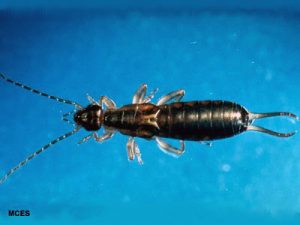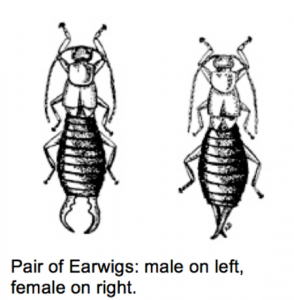Earwigs
By Helen C. Hollingsworth, Fairfax Master Gardener
Earwigs are red-brown to black and range from 1 to 1.25 inches long with two small pairs of wings. They do not fly but can run surprisingly quickly.
 The name “earwig” is thought to have arisen from the false belief that they can crawl into the ears of sleeping people. In some extreme versions of the myth, they can then lay eggs or even drill into the sleeper’s brain. The common aversion to these creatures is probably due to the pincer-like appendages at the tip of the abdomen, which some falsely believe are capable of hurting them. These pincers are used for defense and courtship only. Males have curved pincers while the females’ are smaller and fairly straight.
The name “earwig” is thought to have arisen from the false belief that they can crawl into the ears of sleeping people. In some extreme versions of the myth, they can then lay eggs or even drill into the sleeper’s brain. The common aversion to these creatures is probably due to the pincer-like appendages at the tip of the abdomen, which some falsely believe are capable of hurting them. These pincers are used for defense and courtship only. Males have curved pincers while the females’ are smaller and fairly straight.
The female lays eggs in a chamber 2 to 3 inches below the soil surface and guards them, as well as her newly hatched young until their first molt. They have one generation per year, and some adults (and eggs) survive over the winter, tunneling up to 6 feet below ground.
 Earwigs prefer living in moist locations with lots of organic matter. They are nocturnal and shelter under stones, debris and other moist, dark spots by day. Most earwigs are primarily scavengers, eating dead insects and decaying plants. Some also eat pests such as aphids, insect larvae and snails. They can, however, become a problem when they feed on flowers, seedlings, vegetable crops, and on roots and foliage of living plants. Usually this becomes a significant problem only when populations are high.
Earwigs prefer living in moist locations with lots of organic matter. They are nocturnal and shelter under stones, debris and other moist, dark spots by day. Most earwigs are primarily scavengers, eating dead insects and decaying plants. Some also eat pests such as aphids, insect larvae and snails. They can, however, become a problem when they feed on flowers, seedlings, vegetable crops, and on roots and foliage of living plants. Usually this becomes a significant problem only when populations are high.
The most important step in controlling earwigs is to reduce favorable habitat. Hiding places such as firewood, tarps and boards should be removed from near the foundation. Cracks and gaps around the foundation, doors, windows and other entry points should be sealed. Limiting mulch, plant debris, compost piles and other organic material around the foundation is important.
Chemical control is via a perimeter application around the foundation, including any potential hiding spots. The VCE Pest Management Guide’s recommendations include: indoxacarb Arilon (0.1%), Lambda-cyhalothrin Demand CS (0.03%), fipronil Termidor 80 WG (0.06%) and imidacloprid Temprid SC (0.15%). Follow label instructions on application and use of the product. Indoors, use a vacuum to catch invaders.
“Persistent trapping” is a non-chemical strategy in which rolled-up, moistened newspaper tubes or short segments of hose are set on the soil in likely hiding areas. The earwigs take shelter at the end of the night, and the tubes are shaken out over a bucket of soapy water in the morning, killing them.
Earwigs can be friends in that they are decomposers, contributing to healthy soils, and are predators of some insect pests. However, when populations get too large they can destroy or damage plants in the garden and can become a nuisance in the home. For those with large populations, they are definitely a foe, but they are probably a friend to most of us.
References
• Earwigs in Virginia, VCE Publication 3101-1527 (ENTO 194NP)
• Earwigs, University of Maryland Extension
• Pest Management Guide: Home Grounds and Animals, 2018, Virginia Cooperative Extension, Section 6,
Nuisance Insects of the House and Yard